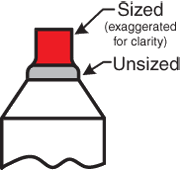22 April 2010, 02:14
Steve LefforgeNew brass compared to fired brass??
Hello
Is there a difference in accuracy between new brass or brass that has been fired at least one time? I realize that brass that is close in weight is more accurate.
Thanks
Steve
22 April 2010, 02:33
Mike1Lot of "ifs" involved there. For example, if they have both been full length sized, I doubt you could tell the difference. There's a long shot of being able to tell the difference, if the once fired was in Your gun and then only neck sized. If the once fired were not in your gun, they may not be from the same lot, while the new ones have a better chance for that. The once fired may be a little longer, which may or may not make a difference.
22 April 2010, 04:24
hivelosityBrass that is fireformed and used in the same rifle will give better life if you do not full length resize. also I cant say brass that is of the same weight will give better accuracy. my opinion that case volume is what is important.
I prefer fire formed brass over new brass,
Dave
22 April 2010, 09:26
WhatTheI second what hivelosity has said with one additional note. You can't do this if you are using your brass in an auto-loader. In that case you will need short dies and the brass well be reformed to the original specs or like new brass.
22 April 2010, 10:52
seafire/B17GI resize new brass just like I do fired brass..
neck size it and bump the shoulder back using a body die..
I also anneal it..
then it doesn't make a difference in my opinion..
23 April 2010, 07:58
TEANCUMquote:
Originally posted by seafire/B17G:
I resize new brass just like I do fired brass..
neck size it and bump the shoulder back using a body die..
I also anneal it..
then it doesn't make a difference in my opinion..
+1
23 April 2010, 08:47
woodsquote:
Originally posted by Steve Lefforge:
Hello
Is there a difference in accuracy between new brass or brass that has been fired at least one time? I realize that brass that is close in weight is more accurate.
Thanks
Steve
IMO, the answer to that is; it depends upon how you resize the fired cases.
If you size the case body, all of the neck and push the shoulder back so there is no contact at the shoulder, then it is essentially the same situation as the new case. Perhaps a little less headspace, but practically the same.
If you Partial Neck size

then you are controlling the position of the case in the chamber by the unsized portion of the neck and the case body filling the chamber. This will be good as long as you are also controlling runout so the bullet will be aligned. If you have bad runout then it would be better to full length resize and let the firing pin align the case by forcing the case into the shoulder cone.
If you have a dedicated neck sizer and do not size the case body then you can have good results if your cases are good quality and do not have a lot of variance in thickness from side to side and the case necks are aligned with the centerline of the case body. If your cases are poor quality then it would be better to FL size and again let the firing pin push the shoulder cone of your case into the cone of the shoulder in the chamber and align your bullet exit that way.
If you can size the case body and leave part of the neck fire formed size and you have controlled runout, then you have the best of all worlds.
IMO. YMMV.
23 April 2010, 18:12
243winxbNew brass is less accurate for me loading 243win. as it comes in bulk packs. I do not size it if brass will chamber.
25 April 2010, 22:49
SnowwolfeSometimes new brass has problems that only shows up when you fire it.
Case in point is a 35 Whelen I am working on at the moment. New Remington brass and it is undersized. Firing pin hits the primer and pushes the case further into the chamber without setting off the primer. Seating the bullets out to engage the lands allows the brass to fire and then the cases are fine.
I've made it a practice over the year to NEVER use new brass for hunting loads and will continue to do so.
